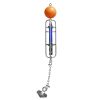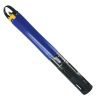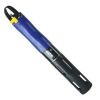NexSens EXO Sonde Mooring Cages
Features
- Integrated mooring clamps sized specifically for EXO sondes
- Hinged pin design allows for quick clamping and release
- Rugged stainless steel frame and PVC clamp construction
- Free ground shipping
- Expedited repair and warranty service
- Lifetime technical support
- More
The NexSens EXO Sonde Mooring Cages provide a secure and convenient means of deploying a YSI EXO multi-parameter water quality sonde. The cage features a 316 stainless steel construction with top and bottom 3/4" eyenuts. The convenient eyenut connection allows the cage to be deployed in-line on an open water buoy mooring or mounted horizontally on a riverbed.
Two integrated PVC mooring clamps are designed specifically for the diameter of a YSI EXO1, EXO2 or EXO3 sonde. Each clamp features a hinged pin design for quick clamping and release. The clamps are positioned at the optimal clamp areas of an EXO sonde so as not to deform the instrument.
An optional mounting crossarm is available for adding photosynthetically active radiation (PAR) sensors. The crossarm allows for both upwelling and downwelling sensors with optional anti-fouling wipers. For saltwater applications, sacrificial zinc shaft anodes are available to attach to the cage and mitigate corrosion during long-term deployments.
- Dimensions: 42" long, 12" diameter
- Weight: 16 lbs.
- Material: 316 SS frame, 316 SS eyenuts, PVC clamps
- Mooring Attachments: (2) 3/4” eyenuts
In The News
Three Decades of Research at Acton Lake
A multi-disciplinary team at Miami University, Ohio, has been studying the environmental change at Acton Lake for over three decades. Using three different NexSens buoys over this time, the team has an incredible archive of data that is helping build a picture of Acton’s past, present, and future. Until recently, a NexSens CB-50 buoy was used alongside other environmental monitoring at Acton Lake. In May 2025, the Miami team deployed a new XB-200 buoy , future-proofing their ongoing monitoring using real-time buoy systems. Acton Lake, a small hypereutrophic reservoir in southwest Ohio, covers 2.4km² and has a maximum depth of about 8m. The dam was built in 1956, and the lake has a large agricultural watershed.
Read MoreSource Water Monitoring in Albany, New York: Tracing Water Quality throughout Tributaries
Thousands of US cities pull their drinking water from natural source waters like reservoirs, rivers, and streams, making overall watershed health a key consideration for water providers. In Albany, New York, the Albany Department of Water and Water Supply delivers drinking water to over 100,000 residents as well as monitors and manages the larger drinking water supply watershed. Hannah Doherty, Environmental Specialist at the Albany Department of Water and Water Supply , spends her days working with a small team to monitor the drinking supply and the connected water bodies. Doherty explains, “We’re the first to encounter the water that ends up being the drinking water.
Read MoreWildfire Prevention in the Sierra Nevada Region with the Yuba Watershed Institute
Though recent wildfires have sparked new conversations about wildfire management and response, groups like the Yuba Watershed Institute have been monitoring the forests and water resources of the Sierra Nevada region for decades, managing approximately 5,000 acres of land with the Bureau of Land Management (BLM) and about 7,000 acres in private land partnerships. The goal of the Institute is to work with local communities and land agencies to improve watershed and forestry management through informed practices and public outreach. The goals of the Yuba Watershed Institute are three-fold: Improve the ability of fire suppression agencies like the California Department of Forestry and Fire Protection ( CAL FIRE ) and the US Forest Service.
Read More













